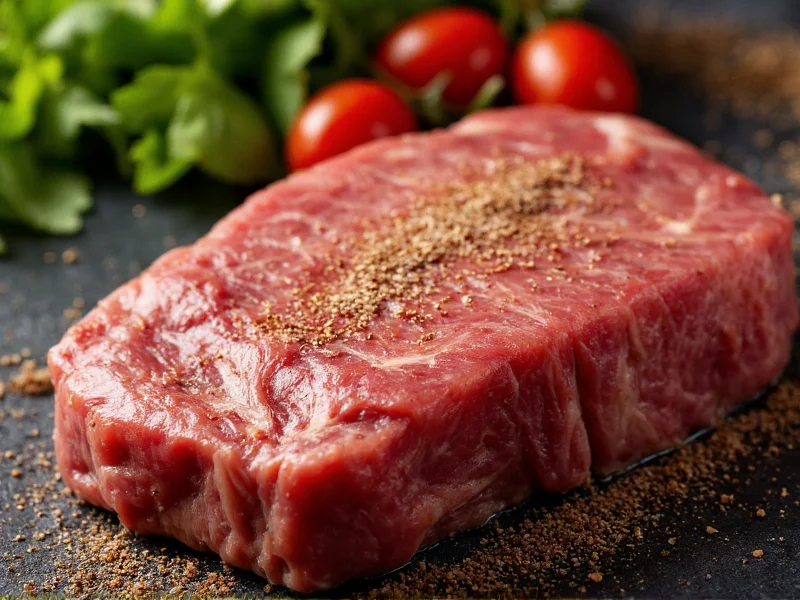Seasoning steak properly transforms a good cut into an exceptional meal. While many complicated blends exist, understanding the fundamentals of steak seasoning delivers better results than following complex recipes without comprehension. The right seasoning technique depends on your steak cut, cooking method, and personal taste preferences.
Why Salt Is Your Most Important Steak Seasoning
Salt isn't just a seasoning—it's a flavor enhancer and texture modifier. When applied properly, salt draws out moisture initially, then allows it to be reabsorbed along with the salt, seasoning the meat from within. This process, called dry brining, creates a more evenly seasoned steak with better crust formation.
The type of salt matters significantly. Kosher salt is preferred by most chefs because its flat crystals adhere well to meat and its lower density prevents over-salting compared to table salt. If using sea salt, opt for coarse varieties that provide similar benefits. Avoid iodized table salt, which can impart metallic notes when heated.
Essential Steak Seasoning Components
While salt forms the foundation, several other ingredients complement steak beautifully:
| Seasoning Component | Best Application Method | Flavor Contribution |
|---|---|---|
| Kosher salt | Dry brine 40-60 minutes before cooking | Enhances natural beef flavor, improves texture |
| Freshly ground black pepper | Apply just before cooking or after searing | Earthy, slightly floral notes without bitterness |
| Garlic powder (not fresh) | Light dusting before cooking | Subtle savory depth without burning |
| Onion powder | Light dusting before cooking | Sweet, savory background notes |
| Dried herbs (thyme, rosemary) | Light application before cooking | Earthy, aromatic complexity |
Simple Steak Seasoning Combinations for Different Preferences
Understanding basic steak seasoning ratios helps you customize to your taste. The following proportions work for a standard 1-1.5 inch thick steak:
Classic Steakhouse Seasoning
This simple blend highlights the beef's natural flavor. Use 1 teaspoon kosher salt and ½ teaspoon freshly ground black pepper per pound of steak. For an authentic steakhouse experience, add a light dusting of garlic powder (about ⅛ teaspoon per pound) just before cooking.
Bold Flavor Profile
For those who enjoy more pronounced seasoning, combine 1 teaspoon kosher salt, ½ teaspoon black pepper, ¼ teaspoon garlic powder, ¼ teaspoon onion powder, and a pinch of dried thyme per pound of steak. This creates a robust flavor without overwhelming the meat.
Minimalist Approach
Sometimes less is more. For high-quality, well-marbled steaks like ribeye or wagyu, use only coarse salt (¾ teaspoon per pound) applied 60 minutes before cooking. The rich marbling provides enough flavor that additional seasonings become unnecessary.
Timing Matters: When to Season Your Steak
The timing of your seasoning dramatically affects the final result:
- Dry brining (40-60 minutes before cooking): Apply salt only during this stage. The salt dissolves in the meat's surface moisture, then gets reabsorbed, seasoning from within while drawing out excess water for better browning.
- Immediately before cooking: Add pepper and any other dry seasonings at this stage to prevent burning (especially important for garlic powder and paprika).
- After cooking: A final light sprinkle of flaky sea salt can enhance texture and provide bursts of flavor.
Avoid seasoning with salt immediately before cooking, as this draws out moisture without allowing time for reabsorption, resulting in poorer sear and potentially steamed rather than seared meat.
Common Steak Seasoning Mistakes to Avoid
Even experienced cooks make these seasoning errors that compromise steak quality:
- Using table salt instead of kosher salt: Table salt's smaller crystals and additives can lead to over-salting and metallic flavors.
- Seasoning too late: Applying salt less than 40 minutes before cooking creates surface moisture that inhibits proper crust formation.
- Adding pepper too early: Ground pepper burns at high searing temperatures, creating bitter compounds.
- Using wet marinades as primary seasoning: Moisture prevents proper browning; save liquid-based seasonings for after cooking.
- Overcomplicating the blend: Too many spices mask the natural beef flavor rather than enhancing it.
Special Considerations for Different Cooking Methods
Your cooking technique affects optimal seasoning approaches:
Grilling: Use slightly more seasoning as some will fall through the grates. Consider adding wood-smoked paprika (¼ teaspoon per pound) to complement the grill flavor. Avoid sugar-based rubs that burn easily over open flame.
Pan-searing: For cast iron cooking, ensure your seasoning doesn't contain sugar, which can create excessive smoke. The hot pan will quickly burn delicate seasonings, so keep blends simple.
Sous vide: Season before vacuum sealing, but remember that sous vide cooking doesn't develop crust, so save additional seasoning for the finishing sear.
Reverse sear: Season after the low-temperature cooking phase, just before the high-heat sear, to prevent seasoning from becoming too concentrated during the long cooking process.











 浙公网安备
33010002000092号
浙公网安备
33010002000092号 浙B2-20120091-4
浙B2-20120091-4